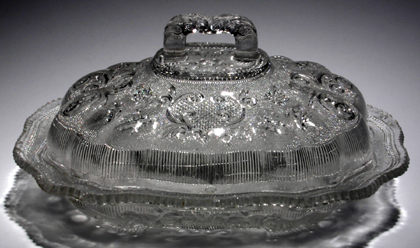Archaeologically and Patently Sandwich
This fine pressed vegetable dish is a classic example of America’s first great contribution to glass technology - the invention of machine pressing.

The subtly curving open-handled lid fits neatly into a matching gallery in the equally subtly-shaped base. A closer look at the lid and base reveals many period motifs: scrolls, hearts, thistles, roses, baskets of fruit, foliage and wreaths. Stippling and fine parallel lines fill the background creating the effect of lace, causing the dish and cover to glisten like the finest cut glass.
This dish illustrates many American innovations in glass pressing. The plain but scalloped outer edge of the base was formed by the so-called cap ring, an ingenious device that brought an illusion of uniform thickness to pieces made from only roughly similar, hand measured gathers of glass. More distinctively, the lid's body and handle were created in a single pressing action using a technique patented in 1830 by Deming Jarves of the Boston and Sandwich Glass Company.
Unlike most early American glass, this dish can be strongly attributed. Excavations by Francis Wynn in the mid-1930s on the site of the Boston and Sandwich Glass Company led to a flourish of scholarly activity. Many familiar pieces became firmly attributed to Sandwich, while any likelihood of a Sandwich attribution was all but removed for many other pieces. This dish, with Jarves' patent handle, is among the larger pieces attributed through Wynn's finds.

